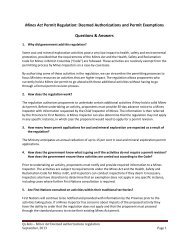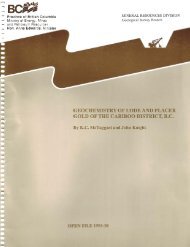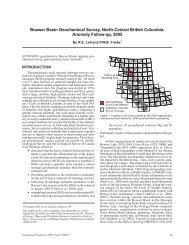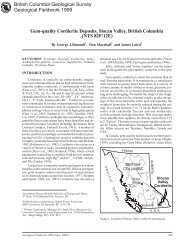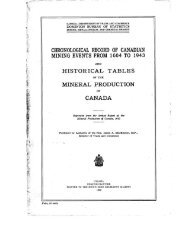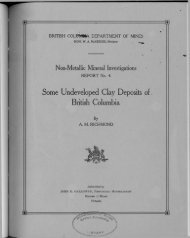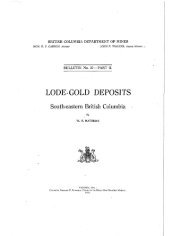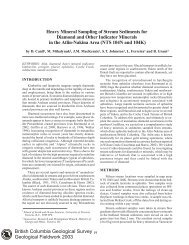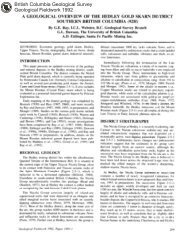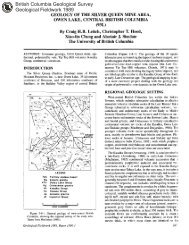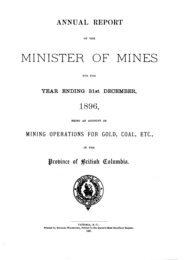PDF version - Ministry of Energy, Mines and Natural Gas
PDF version - Ministry of Energy, Mines and Natural Gas
PDF version - Ministry of Energy, Mines and Natural Gas
Create successful ePaper yourself
Turn your PDF publications into a flip-book with our unique Google optimized e-Paper software.
Mineral Occurrence<br />
Industrial Mineral 21<br />
Industrial minerals, including stone <strong>and</strong> rocks, may be defined as those naturally occurring materials used to<br />
build structures or supply products that are useful to an industrialized society. Since industrial minerals<br />
exclude the ores <strong>of</strong> metals, they have been called the "nonmetallics". Gems <strong>and</strong> art objects are valuable for<br />
their intrinsic properties, but because they are not used in the sense <strong>of</strong> structures or products, they are not<br />
included. Industrial-grade diamonds <strong>and</strong> semiprecious minerals, however, are useful to industry because <strong>of</strong><br />
their hardness <strong>and</strong> are included under abrasives. Listed below are commodities which are considered by<br />
MINFILE to be Industrial Minerals.<br />
Agate<br />
Aggregate<br />
Alunite<br />
Amber<br />
Amethyst<br />
Andalusite<br />
Anhydrite<br />
Apatite<br />
Argillite<br />
Arsenic<br />
Asbestos<br />
Barite<br />
Bentonite<br />
Beryl<br />
Beryllium<br />
Bitumen<br />
Building Stone<br />
Celestite<br />
Ceramic Clay<br />
Chromium<br />
Chrysotile<br />
Clay<br />
Corundum<br />
Diamond<br />
Diatomite<br />
Dimension Stone<br />
Dolomite<br />
Evaporites<br />
Exp<strong>and</strong>ing Shale<br />
Feldspar<br />
Fireclay<br />
Flagstone<br />
Fluorite<br />
Fullers Earth<br />
Garnet<br />
Gemstones<br />
Granite<br />
Graphite<br />
Gravel<br />
Gypsum<br />
Hotspring<br />
Hydromagnesite<br />
Iron<br />
Jade/Nephrite<br />
Kaolinite<br />
Kyanite<br />
Limestone<br />
Magnesite<br />
Unknown ** There is insufficient information to define a deposit classification.<br />
4.6 DEPOSIT TYPE (R30) (E30)<br />
Magnesium<br />
Magnesium Sulphate<br />
Magnetite<br />
Manganese<br />
Marble<br />
Marl<br />
Mica<br />
Nepheline Syenite<br />
Ochre<br />
Olivine<br />
Opal<br />
Peat<br />
Perlite<br />
Phosphate<br />
Phosphorus<br />
Potash<br />
Potassium<br />
Potassium Nitrate<br />
Pozzolan<br />
Pumice<br />
Pyrophyllite<br />
Railroad Ballast<br />
Rhodonite<br />
Ruby<br />
S<strong>and</strong><br />
S<strong>and</strong>stone<br />
Sericite<br />
Shale<br />
Silica<br />
Sillimanite<br />
Slate<br />
Soapstone<br />
Sodalite<br />
Sodium<br />
Sodium Carbonate<br />
Sodium Chloride<br />
Sodium Sulphate<br />
Sulphur<br />
Talc<br />
Titanium<br />
Travertine<br />
Tremolite<br />
Vermiculite<br />
Volcanic Ash<br />
Volcanic Glass<br />
Wollastonite<br />
Zeolite<br />
Zirconium<br />
Deposit types are based on the British Columbia Mineral Deposit Pr<strong>of</strong>iles (http://www.empr.gov.bc.ca/<br />
mining/Geoscience/MineralDepositPr<strong>of</strong>iles/Pages/default.aspx) <strong>of</strong> the BC Geological Survey.<br />
The Deposit type is an attempt to define a deposit based on its characteristics <strong>and</strong> includes/implies an<br />
explanation <strong>of</strong> these characteristics in terms <strong>of</strong> geological processes. The database will accept up to<br />
four Deposit types for any given occurrence. See Appendix XIV for a list <strong>of</strong> all valid Deposit types.<br />
This field is optional since there is <strong>of</strong>ten not enough information to define many occurrences as a<br />
specific deposit type. The coding <strong>of</strong> deposit type is ranked, using the most important type as the first<br />
ranked. The ranked order will be reflected in the printout.<br />
A thorough deposit description should be incorporated in the Capsule Geology <strong>and</strong> should indicate the<br />
geological evidence for any <strong>and</strong> all interpretations.<br />
4.7 AGE OF MINERALIZATION (R24) (E24)<br />
The geologic age <strong>of</strong> the mineralization is indicated with an appropriate era, period or epoch. A complete<br />
listing <strong>of</strong> acceptable codes is provided in Appendix V, Stratigraphic Age Codes <strong>and</strong> is available for<br />
online coding with the list box. This is an optional field <strong>and</strong> should be used only if substantial evidence<br />
supports the data. This evidence must be stated <strong>and</strong> referenced in the Structural <strong>and</strong> Age Comment<br />
field <strong>and</strong> in the Capsule Geology. If the age <strong>of</strong> mineralization is known then the Isotopic age <strong>and</strong><br />
Material Dated fields should also be filled in. When coding via the MINFILE/www online coding card<br />
file:///C|/HardcopyManual/05_codemino.htm (7 <strong>of</strong> 10)2007-09-20 4:09:05 PM



